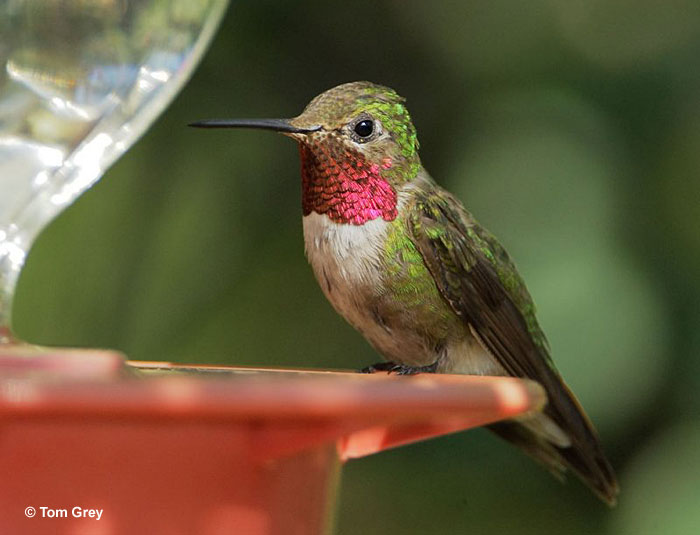The Broad-Tailed Hummingbird is a species of hummingbird found in highland regions of the western United States, Western Canada, Mexico, and Guatemala. These hummingbirds are medium-sized and have iridescent green on their backs, white around the eyes, and a black tail that is rounded and projects past the tips of their wings. That’s actually where they get their name from.
Identification
Male
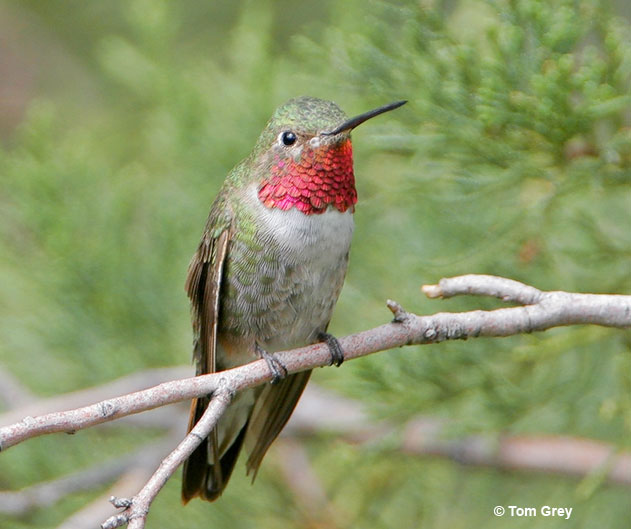
Male Broad-Tailed Hummingbirds have a shiny green color on their higher plumage and head. There’s also a duller green color on the sides. In addition, males have a pinky-red gorget, also known as a throat patch, with a gorgeous red iridescence.
You’ll see a rusty orange color on their tail as well. Males also have a white line that goes from the neck to the eye rings and up to the chin. Lastly, when the males are in flight, their wings make a specific trilling noise that can only be heard from this species.
Female
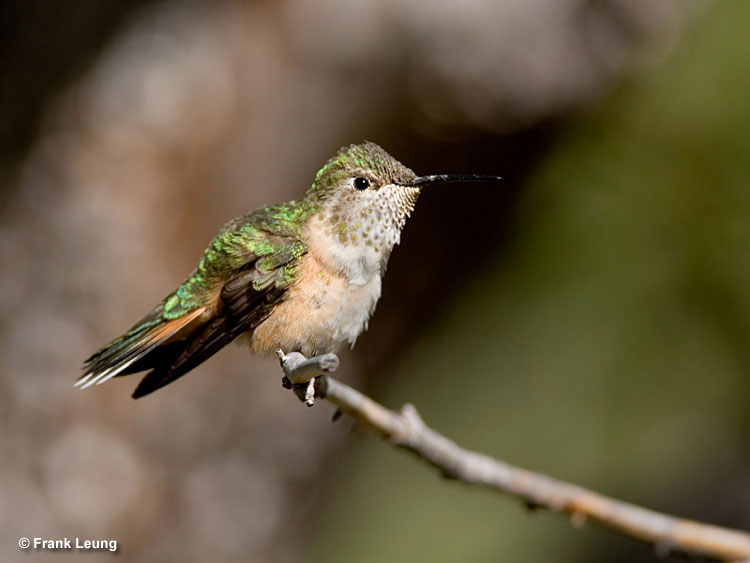
Female Broad-Tailed Hummingbirds are not as colorful as the males. The higher plumage is the same glossy green color as the males.
However, the underside plumage varies from orange-brown to a whitish color. You will see iridescent bronze or green speckles on the upper chest and throat. You’ll see large patches of rusty orange on the sides as well. The middle tail feathers will be green, and the outermost tail feathers are rusty-orange at the base, with black in the center and white at the ends.
Food
Broad-Tailed Hummingbirds’ diet consists primarily of nectar and insects. Nectar is taken from naturally growing flowers; they favor red tubular flowers and sugar-water mixtures in hummingbird feeders. They will also feed on small insects.
When these hummingbirds feed at flowers, you’ll usually find them hovering and reaching into the center of the flower with their bill and long tongue. At hummingbird feeders, they can be seen both hovering and perching. Perching is more likely when the feeder has built-in perches. You may also see them perching in nearby trees or plants guarding the feeder.
When Broad-Tailed Hummingbirds feed on small insects, they may fly out and grab them out of the air or hover next to foliage to pluck them out. They can also be seen taking spiders and trapped insects out of spider webs.
Nesting and Eggs
Male Broad-Tailed Hummingbirds defend their territory by perching up high, where they then scan for intruders. When an intruder is spotted, the male will chase them out. When courting females, male broad-tails will climb high in the air and dive with a loud wing trill. They will repeat this process over and over until a female is courted.
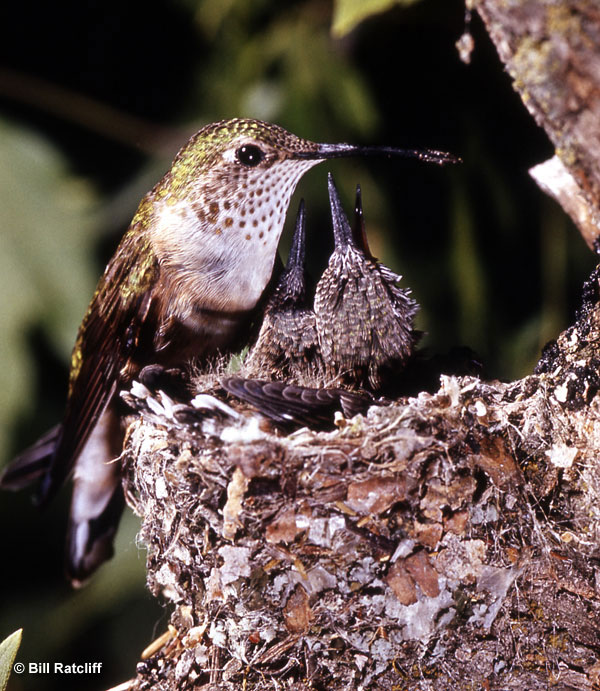
The nest is usually placed under branches that overhang because it keeps the nest warmer and reduces the requirements of nighttime energy from the female. The female will then form the cup part of the nest by twisting the material around with her feet and body while sitting in the nest.
The nest’s inner cup is thicker and made of gossamer and spiderwebs. The nest will have an outer diameter of about two inches and an interior diameter of 0.8 inches.
Most hummingbirds lay two, and rarely one or three eggs can be seen. The eggs are white and are only incubated by the female. Once the young hatch, the female feeds them. Young usually achieve their first flight in around twenty-one to twenty-six days.
Current Situation
Broad-Tailed Hummingbirds live in pinyon-juniper, oak, or pine woodland. They forage for food in grasslands among shrubs and trees or in open areas with flowers. These hummingbirds have a population status of least concern; they’re common and widespread. However, their numbers have declined by over one percent per year, resulting in an increasing decline of approximately forty-five percent between 1966 and 2019.
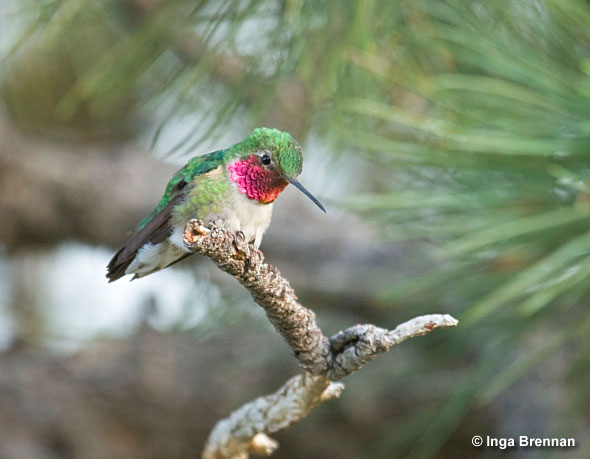
Like most hummingbirds, Broad-Tailed Hummingbirds migrate. They move through highland meadows to access the lowlands that are abundant in flowers. In winter, they head down south and forage in the dry thorn forests, tropical highlands, and pine-oak forests throughout Mexico. During the summer, they head back north to the western states.
As stated previously, Broad-Tailed Hummingbirds are widespread, but their population is declining due to climate change. Climate change is affecting breeding success. The population is also declining due to electric fences, window strikes, and collisions with cars.
Facts
- Hummingbirds have good memories and always remember where good feeding areas are.
- Red is their favorite color. Hummingbirds see red most often. They are more likely to fly to red flowers with deep openings.
- Small hummingbirds that are energetic need a meal every fifteen minutes.
- Male Broad-Tailed Hummingbirds make a high-pitched whistling sound when they beat their wings. For reference, their wings beat anywhere from fifty to eighty times per second.
- Hummingbirds are seen as symbols of luck, happiness, healing, and so much more.
Similar Species
Broad-Tailed Hummingbirds have features that are similar to other hummingbird species. Here are some similar species:
Ruby-throated Hummingbirds
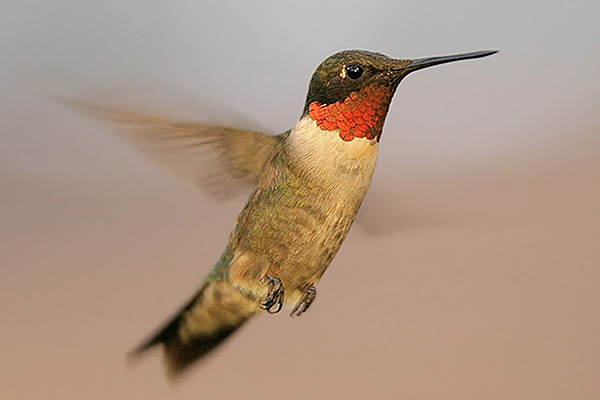
Ruby-throated Hummingbirds can be seen in the eastern United States; the Broad-Tailed Humminbird is primarily found in the western United States. However, there is some overlap regarding their range in the central-eastern US.
The easiest way to identify the hummingbird species is by looking at the shape of the tail. Both male and female Broad-Tailed Hummingbirds have tails that are rounded and broad.
However, female and young male Ruby-Throated Hummingbirds have rounded tails, while the males have forked tails with pointed feathers. Additionally, the adult male Ruby-throated Hummingbird has redder throat feathers and a black chin.
Calliope Hummingbirds
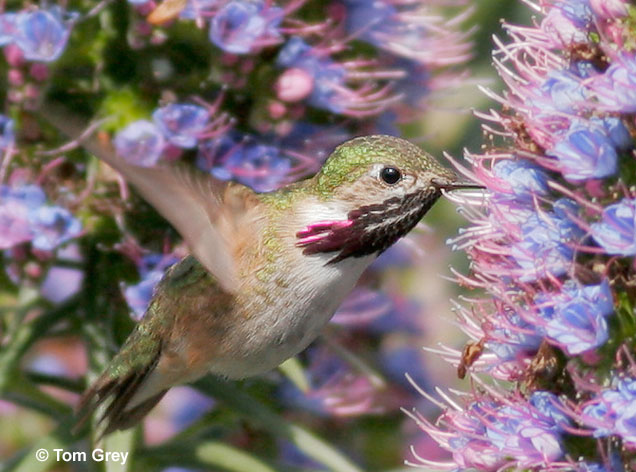
Although Calliope Hummingbirds are similar to Broad-Tailed Hummingbirds in a number of ways, but there are still ways to tell them apart. Calliope Hummingbirds tend to be smaller in size.
Rufous Hummingbirds
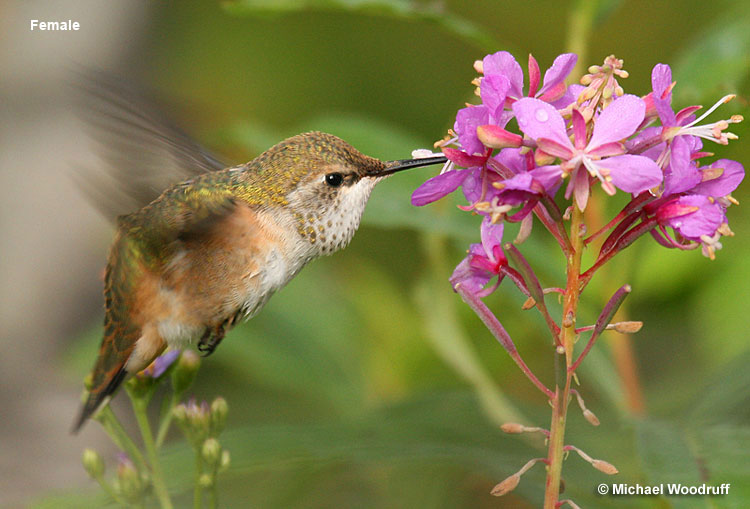
Female Broad-Tailed Hummingbirds can be distinguished from female Rufous Hummingbirds and Allen’s Hummingbirds by the green central tail feathers, the rust-orange color at the base of the tail, and the broader and longer tail overall.
FAQ
Where are Broad-tailed Hummingbirds found?
Broad-tailed Hummingbirds can be found across the Rocky Mountains to southern Montana and west through the forest regions of California and Nevada.
How long does a Broad-tailed Hummingbird live?
Broad-tailed Hummingbirds live to be about two years old.
What is the difference between a Ruby-throated Hummingbird and a Broad-tailed Hummingbird?
The main difference between a Ruby-throated Hummingbird and a Broad-tailed hummingbird is the tail shape and color. Broad-Tailed Hummingbirds have orangey-colored tail feathers, and the tail feathers of Ruby-throated Hummingbirds are green with a little bit of black.
The tails are also shaped differently; Broad-Tailed Hummingbirds have rounded and broad tails. Female and young male Ruby-throated hummingbirds have rounded tails, while the adult males have a forked tails with pointed feathers.

